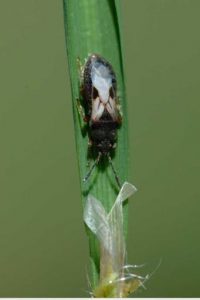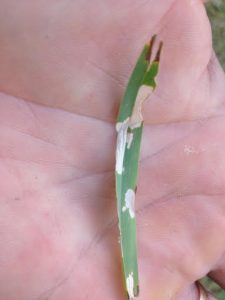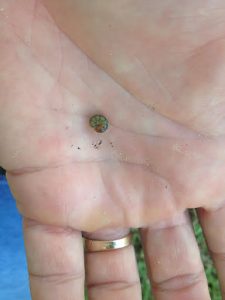Along the Northwest Florida Gulf Coast there are three major insect pests that account for most of the damage to turf grass. They are mole crickets, chinch bugs and sod web worms. Here is a basic guide to recognizing these pests in your lawn.
Mole crickets:
 Mole crickets are somewhat similar in size and shape to other crickets however, their front legs are adapted for digging and tunneling. They are about an inch and a half to two inches in length. They are not native to the area but were imported from South America a number of decades ago and have done a good job establishing themselves here. Mole crickets affect all types of turf grasses.
Mole crickets are somewhat similar in size and shape to other crickets however, their front legs are adapted for digging and tunneling. They are about an inch and a half to two inches in length. They are not native to the area but were imported from South America a number of decades ago and have done a good job establishing themselves here. Mole crickets affect all types of turf grasses.
Mole crickets tunnel just below the surface of the ground and feed on grass roots. Consequently, one of the tell tale signs of these pests is trails about the size of your finger along the surface of the ground where these insects have been active. In areas where the grass is sparse the trails can be quite visible, in areas where the grass has not yet declined they can be harder to spot.
Since mole crickets feed on grass roots, you will find dead grass lying on the surface of the ground with no roots attached in the areas where they are feeding.
Another way to check an area for mole cricket activity is to do a “soap drench”. Fill a 5 gallon bucket with water and dish soap. Empty it over about a 2 foot by 2 foot area. If there are any mole crickets in that area they will immediately come to the surface.
Chinch bugs:
 Chinch bugs are specifically a pest of St. Augustine grass. The adults are tiny black bugs about 1/8th of an inch long with white dots on their backs. The immature ones are red.
Chinch bugs are specifically a pest of St. Augustine grass. The adults are tiny black bugs about 1/8th of an inch long with white dots on their backs. The immature ones are red.
Chinch bugs damage the grass by sucking the juice out of the grass with their needle-like mouth parts. Consequently, the grass will look as if it is not getting enough water and will have an appearance like dried straw. One way of distinguishing between chinch bug activity and drought stress is this: grass affected by drought stress will typically be a uniform brown over a given area, where as grass affected by chinch bugs will have green healthy blades right next to brown dry ones.
Since they live in the thatch area of the grass, chinch bugs can be observed by parting the grass blades so the runners are exposed and watching for movement of the insects. They are so small and quick it is sometimes hard to see them this way. Another way to check for chinch bugs is to take a hollow cylinder (like a coffee can with the ends cut out) and place it over the suspected area of activity and fill it with water, any chinch bugs will float to the top.
Sod web worms:
 Sod web worms are the larval stage of a small brown lawn moth. The moths which are no more than an inch in diameter spend most their time during the day hidden in shrubs. When they come out, they drop their eggs into the grass. When the eggs hatch about a week later, the caterpillars feed on the blades of the grass. The grass will appear to be “skeletonized” with the green chlorophyll material stripped off the leaf and only a translucent skeleton remaining.
Sod web worms are the larval stage of a small brown lawn moth. The moths which are no more than an inch in diameter spend most their time during the day hidden in shrubs. When they come out, they drop their eggs into the grass. When the eggs hatch about a week later, the caterpillars feed on the blades of the grass. The grass will appear to be “skeletonized” with the green chlorophyll material stripped off the leaf and only a translucent skeleton remaining.
Sod web worms can be seen fairly easily in the that
ch area of the lawn by parting the grass blades until the runners are exposed. They are little green caterpillars about 1/2 inch long that usually lie curled up. Sod web worms can affect all types of grasses.

